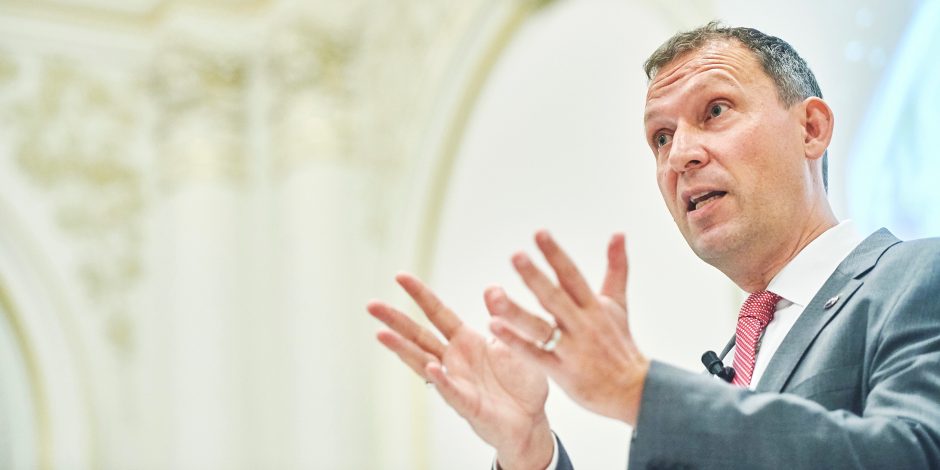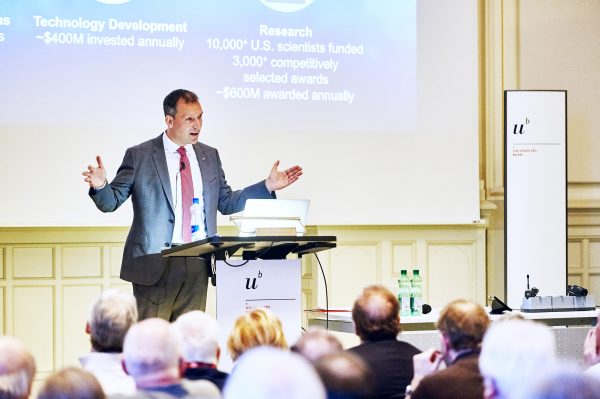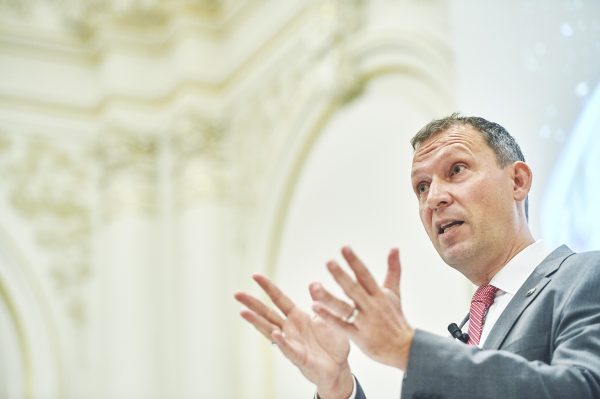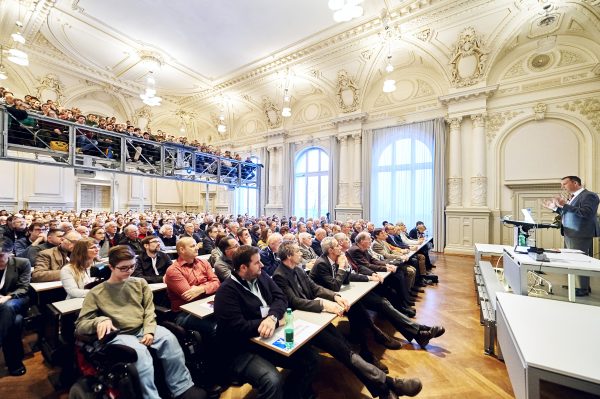“The University of Bern has given me a lot”

As science director of NASA, Thomas Zurbuchen is one of the world’s most influential scientists. In January 2017, he visited the University of Bern, where he studied and gained his PhD in physics. He talked about his work in a public lecture.

Thomas Zurbuchen during his presentation at the University of Bern on Friday January 27 2017. (Photo: Manu Friederich/University of Bern)
“It’s great to come across an instrument that we have talked about for many years,” says Thomas Zurbuchen, as he stands in front of the test plant in the MEFISTO laboratory at the University of Bern. A US instrument is currently calibrated in the measuring chamber. The physicist himself was involved in its development. Someday, this instrument will investigate the heavy, charged particles in the solar wind on-board a European satellite, the Solar Orbiter of the ESA. Zurbuchen explains how the laboratory at the University of Bern is the best in the world in this calibration field, because experts ensure continual, thorough maintenance of the infrastructure. “These are engineers who know what’s going on,” says the head of the NASA science mission directorate.
Zurbuchen studied and worked in the Exact Sciences Building over the course of ten years. He greets his former professors and colleagues warmly in the break room, which still looks the same as it ever did. “Only the coffee machine is new,” observes the prominent guest, who reports about NASA’s recent balloon experiment in Antarctica, and also reveals that he keeps fit in Washington despite his heavy workload and many meetings, with the help of regular training sessions in the weights room and jogging. “I have the body of a farmer and have to exercise,” says the research manager, who is in charge of an annual budget of five billion Dollars and distributes research funds to 10,000 scientists.

49-year old Thomas Zurbuchen studied physics at the University of Bern. He received his PhD in experimental astrophysics in 1996. Before Zurbuchen took up his position as NASA chief scientist in October 2016, he was Professor for Space Research and Aerospace Technology at the University of Michigan in Ann Arbor. He also founded the Center for Entrepreneurship there. In his research, he focuses on solar and heliospheric physics, experimental space research, innovation and entrepreneurialism. Zurbuchen is married and has two children aged 13 and 14. (Photo: Manu Friederich/University of Bern)
Praise for the Swiss school system
Raised in Heiligenschwendi in the Bernese Oberland, Zurbuchen was the first in his family to tackle a degree. The highest NASA scientist credits Switzerland’s successful school system with the fact that a child from a mountain village interested in science was able to gain a PhD in physics and carve out such a good career. “Switzerland should be proud of it,” he says, “And the University of Bern gave me a lot too.” He praises the educational lectures, but also appreciated that he was sent elsewhere to summer schools and had a budget of 50,000 Swiss francs for measuring instruments even back as a degree candidate.
Zurbuchen was well-equipped for anything when he travelled to the USA 20 years ago to take up a place as a postdoc at the University of Michigan. He also researched and taught there as a professor until he moved to Washington last October to become NASA’s new chief scientist and the “first foreigner in this job,” as he puts it. As he presented the speaker to the extremely well-attended audience, Professor Willy Benz emphasised how there is great pride that Bern-based physics has contributed to this extraordinary career. The University of Bern was “like the first stage of the Zurbuchen Rocket”, “It provided the first boost, facilitating the rest of the mission.”
As well as solar research, and the science of earth and planets, astrophysics is also part of Zurbuchen’s repertoire. In 2018, NASA wants to take a new space telescope with a mirror diameter of 6.5 metres into space. Zurbuchen explains how the James Webb telescope is the largest and most important telescope that NASA has ever had. The new instrument is expected to be so good that you could see a bee on the moon. “But – to be honest – we are not yet one-hundred percent sure whether it really works,” admits the NASA chief scientist. An incredibly risky matter, but now and again you have to be a little nervous. Otherwise, you’d spend 20 years in the same place without making any scientific advancement.

Great public interest: The auditorium was full for Thomas Zurbuchens’s lecture. (Photo: Manu Friederich/University of Bern)
From weather forecasting to the theory of relativity
Protecting and improving life on earth, search for life elsewhere and expanding our knowledge: These are the key scientific themes of the American space agency. This is why 88 NASA satellites are currently flying through space. They are used, for example, for weather forecasting, help to bring forest fires under control, are meant to predict tornados and hurricanes, but also find distant exotic or earth-like planets and provide confirmation of Einstein’s general theory of relativity. On Mars, two rovers are currently collecting data. A NASA probe is orbiting Jupiter, another is on the way to asteroids and is expected to bring material from these back to earth.
“One of my tasks is choosing missions,” explains Zurbuchen. His first decision was for a satellite, which will investigate the x-radiation of exotic objects in space, a second mission is expected to fly to a group of asteroids in Jupiter’s orbit, while a third will research the metallic asteroid by the name of Psyche. In response to possible changes at NASA after Donald Trump’s election, Zurbuchen said that, as is always the case, certain projects would be dropped under a new presidency and new ones would begin. He has already met representatives of the new government, but he does not yet know the direction in which changes are to be expected. However, he continues to believe in international collaboration, “Science is international and will remain so.”
Podcast of Thomas Zurbuchen’s public lecture:
Go to the podcast

